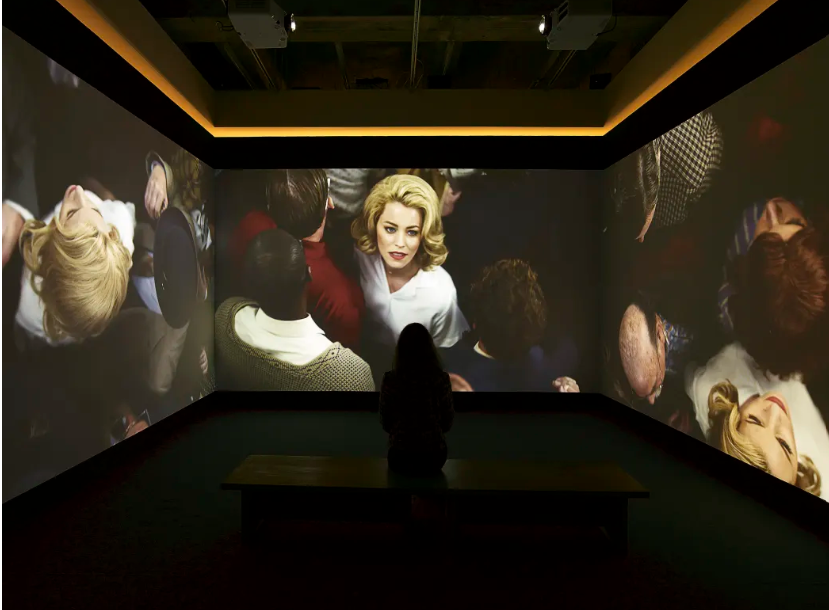The Age : NGV offers a rare glimpse into its hidden treasures (by Kerrie O' Brien)
A young boy and a young girl stand close together, holding a washing basket filled with blankets and something furry. On closer inspection that something is revealed to be a koala with a bandaged foot.
Inspired by recent Australian bushfires, The Rescuers (2021) by Patricia Piccinini is one of the key works acquired by the NGV this year and one of more than 60 on display in Freedom of Movement: Contemporary Art and Design from the NGV Collection, which opens on Saturday.
Curator Amita Kirpalani with a Patricia Piccinini piece as part of the new Freedom of Movement: Contemporary Art and Design exhibition from the NGV.CREDIT:CHRIS HOPKINS
Not far away, a life-sized KAWS cartoon character cradles his head in his hands, looking forlorn, while across the way is Dan Halter’s human sculpture with ubiquitous stripey plastic bags in place of its head.
Housed in the final room of the show, this disparate array of sculptures placed together come alive in a new way. It’s a deliberate positioning, says curator Amita Kirpalani, who says the idea is to put pieces in dialogue with each other in ways they’ve not been before.
At any one time, the NGV has a significant percentage of its riches hidden away out of sight. It’s the same in any of the world’s large galleries, as their floor space simply does not allow all works to be exhibited at once. This exhibition offers a glimpse into some of the key works acquired by the NGV over the past decade – in some ways acting as a survey of the state gallery’s collection across art and design, including contemporary furniture, lighting, painting, film, sculpture and installation, many of which have not been on display for years.
Still from Alex Prager’s Face in the crowd, 2013, video.CREDIT:COURTESY OF THE ARTIST AND LEHMANN MAUPIN, NEW YORK AND HONG KONG
Kirpalani thinks about the exhibition narrative as having three movements: gesture, time and character. “This show is really quirky, it’s really punchy in some sections and a bit more contemplative in others.”
Ideas about migration, humanity, time, life and loss are woven throughout. The first room is very dark and moody, with a stunning piece by Shilpa Gupta called Untitled (Rock), 2012-15 as its centrepiece. A large cave-like black mass, it is made from hundreds of microphones and has an audio track emanating from it, based on a poem by the artist that imagines a world in which people can move freely across borders. Specifically referencing the Partition of India in 1947, Gupta’s work highlights the idea of division and particularly marginalised and overlooked voices.
A number of video works reference Hollywood and deeper issues about identity and globalisation. Cover-Up, 2014, by Adel Abidin is a play on the famous Marilyn Monroe scene from the 1955 film The Seven Year Itch, which sees her standing over a subway grate, her dress billowing up around her while she tries in vain to keep it down. In this piece, an Arab man is featured, and instead of Monroe’s silky halterneck he wears the kandora, a traditional Arabian dress.
Self-taught photographer and filmmaker Alex Prager’s 12-minute video Face in the crowd, 2013, is another highlight. In it, a woman first looks out a window to busy New York streets filled with 1950s-styled characters, then ventures out to join the masses. It conjures similar images from the past few years when we were trapped in our homes as a result of a pandemic, the idea of being alone in a crowd, and the fear of emerging again into large groups of people while the virus remains in circulation.
One room is filled with 32 of Japanese design studio Nendo’s Manga chairs, inspired by the line drawings of Japanese Manga comics. Incorporating their visual vocabulary, such as speech bubbles and movement lines, they illustrate the power of the line to imbue character – one looks like it is shuddering, another joyous.
Along the wall on the outside of the main rooms are a series of iPads featuring David Hockney’s work-in-progress drawings of Yosemite. The NGV owns the prints but the ipads are illuminating as they reveal the artistic process behind them from a blank page, underlining how gestural and detailed they are.
Kirpalani says this is a child-friendly show, with many pieces that will captivate younger visitors; Julian Opie’s fabulous portrait studio opens the same day, which allows children to become the artist, via iPads that allow them to draw self-portraits.
The works featured in Freedom of Movement will be housed in the NGV’s new home for contemporary art and design, The Fox: NGV Contemporary, set to open in 2028 as part of the Melbourne Arts Precinct Transformation.
There’s a lot to take in at the St Kilda Road institution currently, with the Alexander McQueen show opening this week and the recently revealed NGV Architectural Commission, a modern day riff on the Parthenon taking pride of place in the garden out the back.
Freedom of Movement: Contemporary Art and Design from the NGV Collection opens on December 3 and runs until April 10, 2023.
Article published on https://www.theage.com.au


